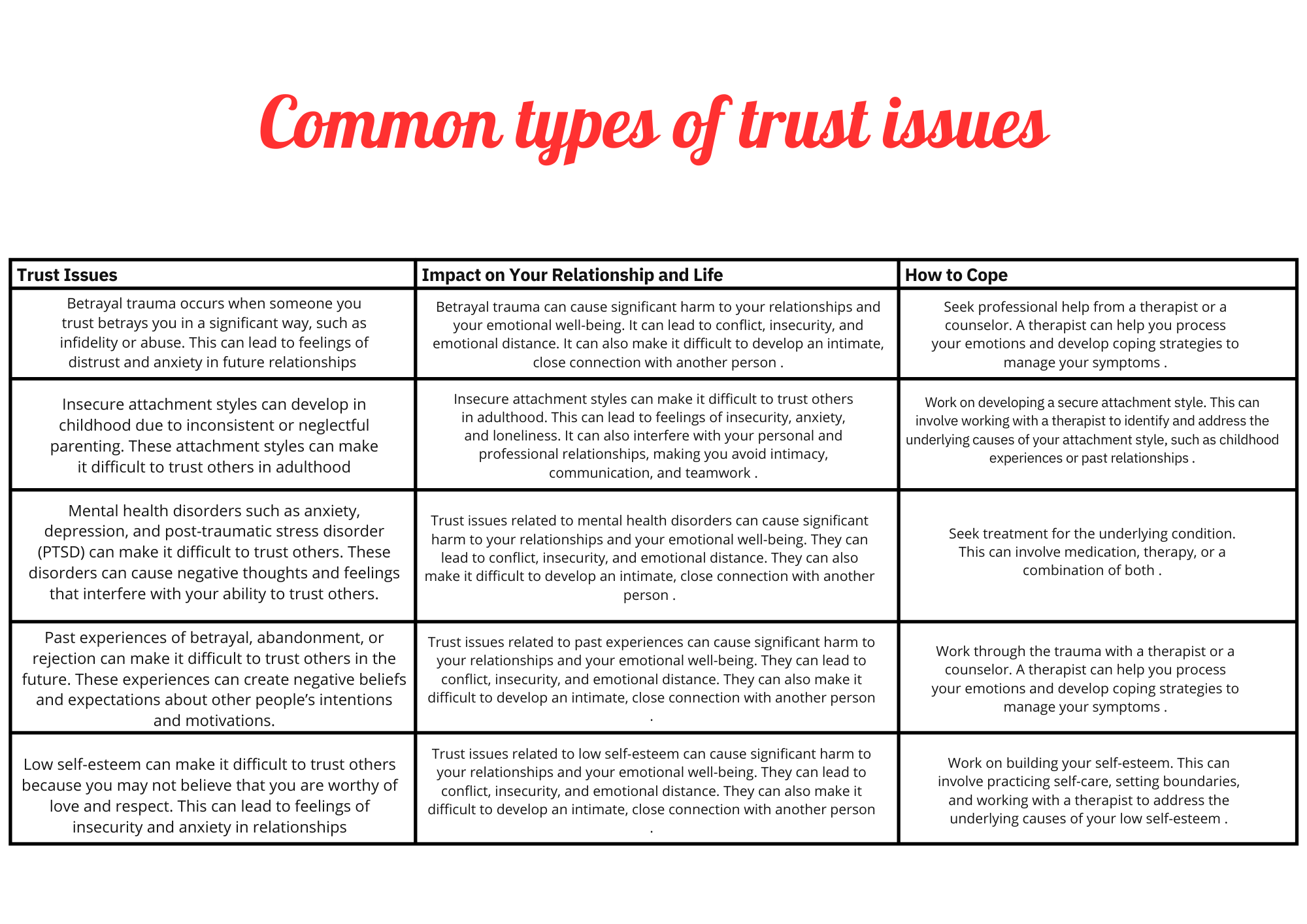trust issues in a relationship

“Ever feel like trust is a tightrope walk in your marriage? You’re not alone. Imagine this: every time your partner is late, your heart sinks. ‘Are they lying?’ you wonder. It’s like a shadow, always there. Trust issues aren’t just doubts. They’re the sneaky thoughts that steal joy from your life. They can make you feel alone, scared, and stuck.
But guess what? It’s not just you. Listen to these eye-openers:
- About 1 in 4 husbands and a bit fewer wives have cheated. Yes, that’s a lot!
- 1 in 5 married folks admit they’ve been unfaithful.
- And here’s a kicker: 3 out of 4 people think trust is key in relationships.
But there’s hope. Couples who tackle trust issues head-on tend to stick together. And therapy? It’s a game changer for 98% of them. Trust me, it’s not just talk. It’s about learning to trust again. Step by step. You learn to open up, set the rules, and heal together.
Ready to jump in and turn things around? Let’s dive deep into what makes trust crumble and how to build it back, brick by brick.”

3 Secret Strategies to Rebuild Trust and Rekindle the Spark

1: The Profound Impact of Intimate Betrayal on Trust in Relationships
Betrayal within the confines of an intimate relationship can send shockwaves through the very foundation on which trust is built. Unlike surface-level breaches, intimate betrayal fractures the ability to trust anyone who dares to get close. As human beings, trust is a fundamental need that mitigates anxiety, depression, and loneliness, fostering an environment where mutual interest and enjoyment can thrive.
However, the aftermath of abuse, infidelity, deceit, or financial manipulation by someone we love leaves an indelible mark on our capacity to trust again1. The aftermath of such betrayal evokes a visceral fear of vulnerability, making the prospect of trusting anew a daunting challenge. The scars of intimate betrayal run deep, impacting not only our perception of the wrongdoer but casting a shadow over the potential for trust in future relationships.
Actionable Strategy: Navigating Betrayal and Rebuilding Trust in Your Marriage

Open and Honest Communication:
- Acknowledge the Betrayal: The first step is acknowledging the betrayal openly and sincerely. Both partners should engage in a candid conversation where the one who breached trust takes responsibility without excuses.
- Create a Safe Space: Establish an environment conducive to open dialogue. Ensure that both partners feel safe expressing their emotions, concerns, and expectations without fear of judgment or reprisal.
- Active Listening: Practice active listening. Each partner should genuinely hear and understand the other’s perspective, fostering empathy and paving the way for mutual understanding.
Understanding Motivations and Apologizing:
- Explore Motivations: The one who breached trust should delve into the motivations behind their actions. Honest self-reflection is crucial for understanding why the betrayal occurred.
- Sincere Apology: Offer a sincere and heartfelt apology, devoid of blame-shifting. Express remorse for the pain caused and articulate a genuine commitment to change.
Respectful Space and Patience:
- Respect Partner’s Pace: Recognize that healing takes time. Respect your partner’s need for space and patience. Avoid pressuring them to forgive or move forward quickly.
- Transparent Patience: Demonstrate patience transparently. Show that you are committed to the process of rebuilding trust, emphasizing consistency in your actions over time.
Building Transparency and Accountability:
- Transparent Communication: Foster transparency in your communication. Share your thoughts, feelings, and experiences openly, leaving no room for ambiguity.
- Accountability Measures: Introduce accountability measures voluntarily. This could include sharing daily activities, being accountable for your whereabouts, and consistently checking in with your partner.
Couples Counseling:
- Seek Professional Guidance: Consider couples counseling as a proactive measure. A skilled therapist can facilitate discussions, identify underlying issues, and provide strategies for rebuilding trust.
- Individual Therapy: Both partners may benefit from individual therapy to address personal challenges and contribute to the overall healing process.
Rebuilding Intimacy Through Shared Experiences:
- Create Positive Memories: Actively engage in shared experiences that promote positive memories. Whether it’s exploring new hobbies together or revisiting cherished places, these moments foster connection and rebuild intimacy.
- Quality Time: Dedicate quality time to each other. Ensure that this time is free from distractions, allowing for genuine connection and rekindling of emotional intimacy.
Continuous Self-Improvement:
- Commit to Personal Growth: Both partners should commit to continuous self-improvement. This may involve addressing personal issues that contributed to the betrayal, fostering an environment of growth within the relationship.
Implementing these actionable strategies requires commitment, honesty, and a shared dedication to rebuilding trust.
While the journey may be challenging, the potential for a stronger, more resilient marriage often emerges when both partners actively engage in the healing process. Remember, each step forward is a mutual investment in the restoration of trust and the preservation of a meaningful connection.
2: Three Responses to Internal Turmoil: Blind Trust, Suspiciousness, and Wise Trust
Navigating internal turmoil within a marriage often prompts distinct responses from individuals.
How they choose to interpret and respond to the emotional challenges can significantly impact the dynamics of the relationship.
Here, we explore three common responses—Blind Trust, Suspiciousness, and Wise Trust—and their implications:
2.1 Blind Trust:
Definition: Blind trust involves an unquestioning belief in a partner’s actions or intentions, regardless of any evidence to the contrary. It often stems from a deep desire to maintain the illusion of a perfect relationship.
Implications:
- Potential Pitfalls: While blind trust may seem comforting, it can lead to overlooking or dismissing legitimate concerns. It might perpetuate a cycle of unresolved issues, as the underlying problems remain unaddressed.
- Impact on Communication: Individuals opting for blind trust may avoid difficult conversations, fearing that acknowledging problems could shatter the illusion. This avoidance hinders open communication, hindering the opportunity for genuine connection.
- Vulnerability to Deception: Blind trust can make individuals vulnerable to manipulation or deception. Unscrupulous behavior may go unnoticed, causing long-term damage to the relationship.
Recommendations:
- Encourage open dialogue: Foster an environment where both partners feel comfortable expressing concerns without fear of judgment.
- Build trust through transparency: Suggest practices that promote transparency, such as sharing thoughts and emotions openly, to create a foundation of trust based on genuine connection.
2.2 Suspiciousness:
Definition: Responding with suspiciousness involves a heightened skepticism or distrust toward a partner’s actions. It may be fueled by past betrayals, ongoing conflicts, or unresolved issues, leading to a constant state of alertness.
Implications:
- Erosion of Trust: Constant suspicion erodes the trust essential for a healthy relationship. Doubting a partner’s intentions can create a self-perpetuating cycle of distrust and defensive behaviors.
- Impact on Emotional Well-being: Individuals adopting a suspicious stance may experience heightened stress and anxiety. The emotional toll of constantly questioning a partner’s motives can lead to emotional exhaustion.
- Communication Breakdown: Suspiciousness can result in poor communication, with partners reluctant to share openly due to the fear of being misunderstood or judged.
Recommendations:
- Facilitate open conversations: Encourage couples to explore the root causes of suspiciousness through open, non-confrontational conversations.
- Seek professional guidance: Suggest couples therapy as a valuable resource to address deep-seated issues contributing to suspiciousness and work towards rebuilding trust.
2.3 Wise Trust:
Definition: Wise trust involves a balanced approach that combines trust with a realistic understanding of the complexities within a relationship. It acknowledges the potential for challenges while actively working towards building and maintaining trust.
Implications:
- Realistic Expectations: Wise trust allows for realistic expectations, recognizing that no relationship is without its difficulties. It promotes an acceptance of imperfections and a commitment to working through challenges together.
- Promotes Growth: Individuals practicing wise trust understand that challenges are opportunities for growth. They view relationship struggles as a chance to learn more about themselves and their partner, fostering personal and collective development.
- Healthy Communication: Wise trust encourages healthy communication, where both partners feel secure expressing their thoughts and emotions. It fosters an environment where concerns can be addressed constructively.
Recommendations:
- Emphasize open communication: Advocate for open and honest communication as the foundation of wise trust, allowing partners to navigate challenges collaboratively.
- Encourage mutual support: Highlight the importance of supporting each other through difficult times, recognizing that wise trust is a joint effort to strengthen the relationship.
Actionable Strategy for All Responses:
Regardless of the response—blind trust, suspiciousness, or wise trust—a common actionable strategy is to implement regular relationship check-ins.
These check-ins provide a structured and non-confrontational space for partners to express their feelings, concerns, and needs.
Steps for Relationship Check-Ins:
- Schedule Regular Sessions: Set aside dedicated time, whether weekly or bi-weekly, for relationship check-ins. This establishes a routine that promotes consistent communication.
- Create a Safe Environment: Ensure that the check-ins are conducted in a safe and comfortable environment. This might include a quiet space where both partners can openly share without interruptions.
- Use “I” Statements: Encourage partners to use “I” statements to express their feelings and concerns without blaming the other. This fosters personal responsibility and prevents defensiveness.
- Active Listening: Practice active listening during the check-ins. Both partners should make a conscious effort to listen attentively to each other’s perspectives without interrupting.
- Reflect and Respond: After one partner shares, allow a moment for reflection before responding. This prevents impulsive reactions and promotes thoughtful, constructive dialogue.
By incorporating regular relationship check-ins, couples can create a consistent and supportive framework for addressing internal turmoil, fostering understanding, and collaboratively working towards a healthier relationship.
3: Assessing the Probability of Betrayal: Observing Responses to Vulnerability
How partners respond to each other’s vulnerabilities can serve as a powerful indicator of the relationship’s resilience or susceptibility to betrayal. Let’s delve into this critical aspect, exploring various dimensions of responses to vulnerability:
4.1 Expressions of Vulnerability:
Definition: Expressing vulnerability involves revealing one’s true emotions, fears, and needs, creating a space for genuine connection. It’s an act of trust that opens the door to deeper intimacy.
Implications:
- Foundation of Connection: Partners sharing vulnerabilities contribute to the foundation of a connected and emotionally rich relationship. It fosters an environment where both individuals feel seen, heard, and understood.
- Risk of Betrayal: The act of vulnerability inherently carries a perceived risk of betrayal. Partners may fear that exposing their true selves makes them susceptible to rejection or exploitation.
- Catalyst for Growth: When vulnerability is met with understanding and support, it becomes a catalyst for personal and relational growth. However, negative responses can hinder this potential, leading to emotional distance.
Recommendations:
- Encourage Mutual Vulnerability: Promote an environment where both partners feel encouraged to express vulnerabilities without fear of judgment.
- Establish Emotional Safety: Emphasize the importance of creating emotional safety within the relationship. This involves building trust that vulnerabilities will be met with empathy and support.
4.2 Positive Responses to Vulnerability:
Definition: Positive responses involve partners reacting with empathy, understanding, and support when faced with each other’s vulnerabilities. It creates a reinforcing cycle of trust and connection.
Implications:
- Strengthening Trust: Positive responses strengthen the foundation of trust within the relationship. Partners learn that vulnerability is met with compassion, reducing the fear of betrayal.
- Enhanced Emotional Intimacy: A pattern of positive responses enhances emotional intimacy, deepening the connection between partners. It allows for a more authentic and fulfilling bond.
- Encouraging Open Communication: Positive responses create a culture of open communication. Partners feel more comfortable discussing their feelings, needs, and concerns, fostering a sense of mutual understanding.
Recommendations:
- Practice Active Listening: Encourage partners to practice active listening when the other expresses vulnerability. This involves fully engaging in the conversation without judgment or interruption.
- Express Gratitude for Openness: Reinforce the importance of expressing gratitude when a partner shares vulnerabilities. This acknowledgment encourages ongoing openness.
4.3 Negative Responses to Vulnerability:
Definition: Negative responses encompass reactions such as dismissal, judgment, or avoidance when faced with a partner’s vulnerabilities. These responses can contribute to a climate of mistrust.
Implications:
- Erosion of Trust: Negative responses erode the trust that underpins a healthy relationship. Partners may become hesitant to share vulnerabilities, fearing negative consequences.
- Impact on Emotional Safety: The emotional safety of the relationship is compromised when vulnerability is met with negativity. It creates an atmosphere of insecurity and emotional distance.
- Potential for Betrayal: Persistent negative responses may heighten the perceived probability of betrayal. Partners may question the durability of the relationship, increasing vulnerability to external temptations.
Recommendations:
- Encourage Reflective Communication: Prompt partners to reflect on their reactions to a partner’s vulnerability. Understanding the impact of negative responses is crucial for fostering positive change.
- Seek Couples Counseling: In cases of recurring negative responses, couples counseling can provide a structured space for addressing underlying issues and improving communication.
Actionable Strategy for Assessing the Probability of Betrayal:
To assess the probability of betrayal, couples can implement a practice of joint vulnerability reflection sessions. These sessions provide a dedicated time for partners to openly discuss their feelings of vulnerability, share any concerns about potential betrayals, and collaboratively devise strategies to strengthen trust.
Steps for Joint Vulnerability Reflection Sessions:
- Schedule Regular Sessions: Set aside specific times, perhaps monthly, for joint vulnerability reflection sessions. This consistency allows for ongoing assessment and adjustment.
- Openly Share Feelings: Each partner takes turns sharing recent instances of vulnerability and how they felt in response. This sharing fosters mutual understanding.
- Identify Triggers and Patterns: Discuss any triggers or patterns that may contribute to feelings of vulnerability or concerns about potential betrayal. Identifying these allows for proactive management.
- Co-create Strategies: Collaboratively devise strategies to address and alleviate concerns. This might involve setting clear communication expectations, defining boundaries, or exploring joint activities that strengthen emotional bonds.
- Reflect on Progress: Regularly reflect on the progress made in managing vulnerability and strengthening trust. This ongoing reflection ensures that the strategies remain effective and adaptable.
“Ready to Bulletproof Your Love?
Think about this: What if you could spot a trust-breaker before it even happens? That’s right, by talking and sharing the real stuff — the fears, the hopes, the nitty-gritty of your day — you build a love that’s tough as nails. It’s like being detectives in your own love story. You’re not just talking; you’re building a fortress of trust.
So, here’s the deal: Sit down together, regularly. Share what’s in your heart. Listen, like really listen, to what your partner says. Spot those little signs that might mean trouble. Then, work on them, together. It’s like playing on the same team, against the world.
This isn’t just chit-chat. It’s like putting armor around your relationship. Each word, each shared moment, each understanding glance — they’re all bricks in a wall that keeps betrayal out.
By diving deep into each other’s hearts and minds, you’re not just avoiding problems; you’re making your relationship rock solid. It’s about being open, being real, and most of all, being together in this journey. So, are you ready to turn your love into an unbreakable bond?”